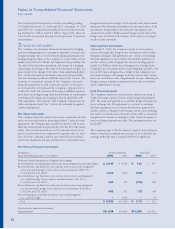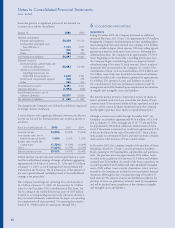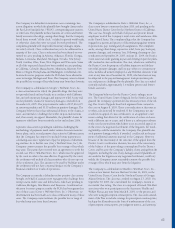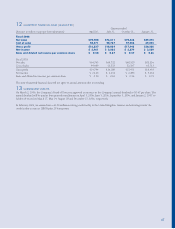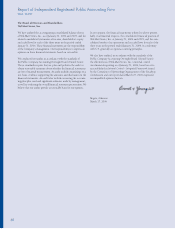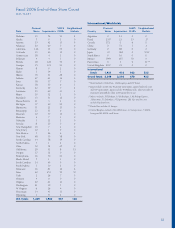Walmart 2006 Annual Report Download - page 46
Download and view the complete annual report
Please find page 46 of the 2006 Walmart annual report below. You can navigate through the pages in the report by either clicking on the pages listed below, or by using the keyword search tool below to find specific information within the annual report.
Notes to Consolidated Financial Statements
WAL-MART
44
fees. The complaint alleges that the Company’s Health Plan violates
Title VII’s prohibition against gender discrimination in that the
Health Plan’s Reproductive Systems provision does not provide
coverage for prescription contraceptives. The Company cannot
estimate the possible loss or range of loss which may arise from
this litigation.
The Company is a defendant in a lawsuit that was fi led on
August 24, 2001, in the United States District Court for the
Eastern District of Kentucky. EEOC (Janice Smith) v. Wal-Mart
Stores, Inc. is an action brought by the EEOC on behalf of Janice
Smith and all other females who made application or transfer
requests at the London, Kentucky, distribution center from 1995 to
the present, and who were not hired or transferred into the ware-
house positions for which they applied. The class seeks back pay
for those females not selected for hire or transfer during the relevant
time period. The class also seeks injunctive and prospective affi r-
mative relief. The complaint alleges that the Company based hiring
decisions on gender in violation of Title VII of the 1964 Civil Rights
Act as amended. The EEOC can maintain this action as a class with-
out certifi cation. The Company cannot estimate the possible loss
or range of loss which may arise from this litigation.
On November 8, 2005, the Company received a grand jury sub-
poena from the United States Attorney’s Offi ce for the Central
District of California, seeking documents and information relating
to the Company’s receipt, transportation, handling, identifi cation,
recycling, treatment, storage and disposal of certain merchandise
that constitutes hazardous materials or hazardous waste. The
Company has been informed by the U.S. Attorney’s Offi ce for the
Central District of California that it is a target of a criminal investi-
gation into potential violations of the Resource Conservation and
Recovery Act (“RCRA”), the Clean Water Act, and the Hazardous
Materials Transportation Statute. This U.S. Attorney’s Offi ce con-
tends, among other things, that the use of Company trucks to trans-
port certain returned merchandise from the Company’s stores
to its return centers is prohibited by RCRA because those materials
may be considered hazardous waste. The government alleges that,
to comply with RCRA, the Company must ship from the store cer-
tain materials as “hazardous waste” directly to a certifi ed disposal
facility using a certifi ed hazardous waste carrier. The Company con-
tends that the practice of transporting returned merchandise to its
return centers for subsequent disposition, including disposal by cer-
tifi ed facilities, is compliant with applicable laws and regulations.
Additionally, the U.S. Attorney’s Offi ce in the Northern District
of California has initiated its own investigation regarding the
Company’s handling of hazardous materials and hazardous waste
and the Company has received administrative document requests
from the California Department of Toxic Substances Control
requesting documents and information with respect to two of
the Company’s distribution facilities. Further, the Company
also received a subpoena from the Los Angeles County District
Attorney’s Offi ce for documents and administrative interrogato-
ries requesting information, among other things, regarding the
Company’s handling of materials and hazardous waste. California
state and local government authorities and the State of Nevada
have also initiated investigations into these matters. The Company
is cooperating fully with the respective authorities.
The Company cannot estimate the possible loss or range of loss
which may arise from this matter.
9 COMMITMENTS
The Company and certain of its subsidiaries have long-term leases
for stores and equipment. Rentals (including, for certain leases,
amounts applicable to taxes, insurance, maintenance, other operat-
ing expenses and contingent rentals) under operating leases and
other short-term rental arrangements were $1.3 billion, $1.2 billion
and $1.1 billion in 2006, 2005 and 2004, respectively. Aggregate
minimum annual rentals at January 31, 2006, under non-cancelable
leases are as follows (in millions):
Operating Capital
Fiscal Year Leases Leases
2007 $ 797 $ 592
2008 751 588
2009 710 550
2010 634 526
2011 586 514
Thereafter 6,205 3,610
Total minimum rentals $9,683 6,380
Less estimated executory costs 39
Net minimum lease payments 6,341
Less imputed interest at rates ranging
from 3.0% to 29.0% 2,300
Present value of minimum lease payments $4,041
The Company has entered into sale/leaseback transactions involv-
ing buildings and the underlying land that were accounted for as
capital and operating leases. Included in the annual maturities
schedule above are $429 million of capital leases and $140 million
of operating leases.
Certain of the Company’s leases provide for the payment of contin-
gent rentals based on a percentage of sales. Such contingent rentals
amounted to $27 million, $32 million and $38 million in 2006,
2005 and 2004, respectively. Substantially all of the Company’s
store leases have renewal options, some of which may trigger an
escalation in rentals.
In connection with certain debt fi nancing, we could be liable
for early termination payments if certain unlikely events were to
occur. At January 31, 2006, the aggregate termination payment
was $89 million. These two arrangements expire in fi scal 2011
and fi scal 2019.
In connection with the development of our grocery distribution
network in the United States, we have agreements with third par-
ties which would require us to purchase or assume the leases on
certain unique equipment in the event the agreements are termi-
nated. These agreements, which can be terminated by either party
at will, cover up to a fi ve-year period and obligate the Company to
pay up to approximately $233 million upon termination of some
or all of these agreements.






